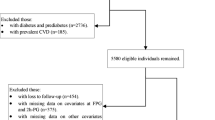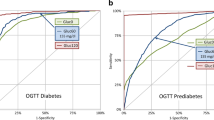Abstract
Glucose tolerant subjects with 1-h post-load glucose ≥155 mg/dl (NGT-1 h-high) are at increased risk for type 2 diabetes (T2DM). Prospective studies showed that chronic subclinical inflammation is a predictor of T2DM. In this study, we aimed to evaluate the inflammatory profile in NGT-1 h-high subjects as compared with individuals with 1-h post-load glucose <155 mg/dl (NGT-1 h-low). To this end, an oral glucose tolerance tests (OGTT) were performed in 1,099 nondiabetic whites. Cardio-metabolic risk factors including high-sensitivity C-reactive protein (hsCRP), erythrocyte sedimentation rate (ESR), fibrinogen, and complement C3 (C3) were determined. Of the 1,099 subjects examined, 497 had NGT-1 h-low, 154 had NGT-1 h-high, 158 had isolated impaired fasting glucose (IFG), and 290 had impaired glucose tolerance (IGT). As compared with NGT-1 h-low, NGT-1 h-high and IGT subjects exhibited significantly higher hsCRP, ESR, fibrinogen, and C3 levels. Notably, hsCRP, ESR, and C3 were also significantly higher as compared with IFG individuals. In a logistic regression analysis adjusted for age and gender, NGT-1 h-high and IGT subjects had a 1.8-fold increased risk of having the highest value of the Inflammatory Score. These data suggest that a value of a 1-h OGTT glucose ≥155 mg/dl may be helpful to identify a subset of normal glucose tolerance individuals at risk for chronic subclinical inflammation, a predictor of T2DM, and cardiovascular diseases.
Similar content being viewed by others
References
Tuomilehto J, Lindström J, Eriksson JG et al (2001) Prevention of type 2 diabetes mellitus by changes in lifestyle among subjects with impaired glucose tolerance. N Engl J Med 344:1343–1350
Knowler WC, Barrett-Connor E, Fowler SE et al (2002) Reduction in the incidence of type 2 diabetes with lifestyle intervention or metformin. N Engl J Med 346:393–403
Chiasson JL, Josse RG, Gomis R et al (2002) Acarbose for prevention of type 2 diabetes mellitus: the STOP-NIDDM randomised trial. Lancet 359:2072–2077
DeFronzo RA, Tripathy D, Schwenke DC et al (2011) Pioglitazone for diabetes prevention in impaired glucose tolerance. N Engl J Med 364:1104–1115
Chiasson JL, Josse RG, Gomis R et al (2003) Acarbose treatment and the risk of cardiovascular disease and hypertension in patients with impaired glucose tolerance: the STOP-NIDDM trial. JAMA 290:486–494
Ratner R, Goldberg R, Haffner S et al (2005) Impact of intensive lifestyle and metformin therapy on cardiovascular disease risk factors in the diabetes prevention program. Diabetes Care 28:888–894
Nathan DM, Davidson MB, DeFronzo RA et al (2007) Impaired fasting glucose and impaired glucose tolerance: implications for care. Diabetes Care 30:753–759
Laakso M, Zilinskaite J, Hansen T et al (2008) Insulin sensitivity, insulin release and GLP-1 levels in subjects with IFG and/or IGT in the EUGENE2 study. Diabetologia 51:502–511
Cardellini M, Andreozzi F, Laratta E et al (2007) Plasma interleukin-6 levels are increased in subjects with impaired glucose tolerance but not in those with impaired fasting glucose in a cohort of Italian Caucasians. Diabetes Metab Res Rev 23:141–145
Unwin N, Shaw J, Zimmet P, Alberti KG (2002) Impaired glucose tolerance and impaired fasting glycemia: the current status on definition and intervention. Diabet Med 19:708–723
Abdul-Ghani MA, Abdul-Ghani T, Ali N, Defronzo RA (2008) One-hour plasma glucose concentration and the metabolic syndrome identify subjects at high risk for future type 2 diabetes. Diabetes Care 31:1650–1655
Abdul-Ghani MA, Lyssenko V, Tuomi T et al (2009) Fasting versus post-load plasma glucose concentration and the risk for future type 2 diabetes: results from the Botnia study. Diabetes Care 32:281–286
Succurro E, Marini MA, Arturi F et al (2009) Elevated one-hour post-load plasma glucose levels identifies subjects with normal glucose tolerance but early carotid atherosclerosis. Atherosclerosis 207:245–249
Succurro E, Arturi F, Lugarà M et al (2010) One-hour post-load plasma glucose levels are associated with kidney dysfunction. Clin J Am Soc Nephrol 5:1922–1927
Bardini G, Dicembrini I, Cresci B, Rotella CM (2010) Inflammation markers and metabolic characteristics of subjects with 1-h plasma glucose levels. Diabetes Care 33:411–413
Sciacqua A, Miceli S, Carullo G et al (2011) One-hour post-load plasma glucose levels and left ventricular mass in hypertensive patients. Diabetes Care 34:1406–1411
Sciacqua A, Miceli S, Greco L et al (2011) One-hour post-load plasma glucose levels and diastolic function in hypertensive patients. Diabetes Care 34:2291–2296
Succurro E, Arturi F, Grembiale A et al (2011) One-hour post-load plasma glucose levels are associated with elevated liver enzymes. Nutr Metab Cardiovasc Dis 21:713–718
Marini MA, Succurro E, Frontoni S et al (2012) Insulin sensitivity, β-cell function, and incretin effect in individuals with elevated 1-h postload plasma glucose levels. Diabetes Care 35:868–872
Perticone F, Sciacqua A, Tassone EJ et al (2012) One-hour post-load plasma glucose and IGF-1 in hypertensive patients. Eur J Clin Invest 42:1325–1331
Perticone F, Sciacqua A, Perticone M et al (2012) Serum uric acid and 1-h postload glucose in essential hypertension. Diabetes Care 35:153–157
Sciacqua A, Maio R, Miceli S et al (2012) Association between one-hour post-load plasma glucose levels and vascular stiffness in essential hypertension. PLoS ONE 7:e44470
Orencia AJ, Daviglus ML, Dyer AR et al (1997) One hour postload plasma glucose and risks of fatal coronary heart disease and stroke among nondiabetic men and women: the Chicago Heart Association Detection Project in Industry (CHA) Study. J Clin Epidemiol 50:1369–1376
Strandberg TE, Pienimäki T, Strandberg AY et al (2011) One-hour glucose, mortality, and risk of diabetes: a 44-year prospective study in men. Arch Intern Med 171:941–943
Duncan BB, Schmidt MI, Pinked JS et al (2003) Low-grade systemic inflammation and the development of type 2 diabetes. The arteriosclerosis risk in communities study. Diabetes 52:1799–1805
Perticone F, Maio R, Sciacqua A et al (2008) Endothelial dysfunction and CRP are risk factors for diabetes in essential hypertension. Diabetes 57:167–171
Emerging Risk Factors Collaboration, Kaptoge S, Di Angelantonio E et al (2012) C-reactive protein, fibrinogen, and cardiovascular disease prediction. N Engl J Med 367:1310–1320
Ridker PM, Wilson PW, Grundy SM (2004) Should C-reactive protein be added to metabolic syndrome and to assessment of global cardiovascular risk? Circulation 109:2818–2825
Ford ES (2002) Leukocyte count, erythrocyte sedimentation rate, and diabetes incidence in a national sample of US adults. Am J Epidemiol 155:57–64
Schmidt MI, Duncan BB, Sharett AR et al (1999) Markers of inflammation and prediction of diabetes mellitus in adults (Atherosclerosis Risk in Communities study): a cohort study. Lancet 353:1649–1652
Engstrom G, Hedblad B, Eriksson KF et al (2005) Complement C3 is a risk factor for the development of diabetes: a population-based cohort study. Diabetes 54:570–575
Hess K, Alzahrani SH, Mathai M et al (2013) A novel mechanism for hypofibrinolysis in diabetes: the role of complement C3. Diabetologia 55:1103–1113
Matsuda M, De Fronzo RA (1999) Insulin sensitivity indices obtained from oral glucose tolerance testing: comparison with the euglycemic insulin clamp. Diabetes Care 22:1462–1470
Levitan EB, Song Y, Ford ES, Liu S (2004) Is nondiabetic hyperglycemia a risk factor for cardiovascular disease? A meta-analysis of prospective studies. Arch Intern Med 164:2147–2155
Abdul-Ghani MA, Williams K, DeFronzo RA, Stern M (2007) What is the best predictor of future type 2 diabetes? Diabetes Care 30:1544–1548
Esposito K, Nappo F, Marfella R et al (2002) Inflammatory cytokine concentrations are acutely increased by hyperglycemia in humans: role of oxidative stress. Circulation 106:2067–2072
Verma S, Wang CH, Li SH et al (2002) A self-fulfilling prophecy: C-reactive protein attenuates nitric oxide production and inhibits angiogenesis. Circulation 106:913–919
D’Alessandris C, Lauro R, Presta I, Sesti G (2007) C-Reactive protein induces phosphorylation of insulin receptor substrate-1 on Ser307 and Ser612 in L6 myocytes, thereby impairing the insulin signalling pathway that promotes glucose transport. Diabetologia 50:840–849
Acknowledgments
This work was supported, in part, by Italian Ministry of University Grant FIRB/MERIT RBNE08NKH7_002 to G.S.
Conflict of interest
None.
Human and Animal Rights
All procedures followed were approved by approved Institutional Ethics Committee of the University of Rome Tor Vergata and Catanzaro and in accordance with the ethical of the Helsinki declaration of 1975, as revised in 2008.
Informed Consent
Informed consent was obtained from all patients for being included in the study.
Author information
Authors and Affiliations
Corresponding author
Additional information
Managed by Massimo Federici.
Rights and permissions
About this article
Cite this article
Sesti, G., Fiorentino, T.V., Succurro, E. et al. Elevated 1-h post-load plasma glucose levels in subjects with normal glucose tolerance are associated with unfavorable inflammatory profile. Acta Diabetol 51, 927–932 (2014). https://doi.org/10.1007/s00592-013-0539-x
Received:
Accepted:
Published:
Issue Date:
DOI: https://doi.org/10.1007/s00592-013-0539-x




